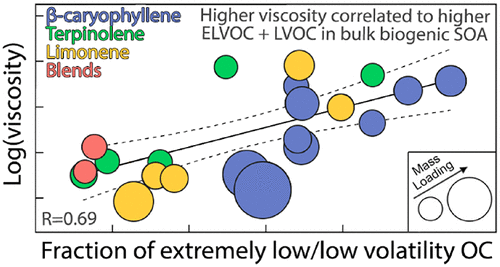当前位置:
X-MOL 学术
›
Environ. Sci. Technol. Lett.
›
论文详情
Our official English website, www.x-mol.net, welcomes your
feedback! (Note: you will need to create a separate account there.)
Volatility and Viscosity Are Correlated in Terpene Secondary Organic Aerosol Formed in a Flow Reactor
Environmental Science & Technology Letters ( IF 8.9 ) Pub Date : 2019-08-13 , DOI: 10.1021/acs.estlett.9b00412 Wyatt M. Champion 1 , Nicholas E. Rothfuss 2 , Markus D. Petters 2 , Andrew P. Grieshop 1
Environmental Science & Technology Letters ( IF 8.9 ) Pub Date : 2019-08-13 , DOI: 10.1021/acs.estlett.9b00412 Wyatt M. Champion 1 , Nicholas E. Rothfuss 2 , Markus D. Petters 2 , Andrew P. Grieshop 1
Affiliation

|
Secondary organic aerosol (SOA) is a complex mixture of largely unspeciated compounds. The volatility and viscosity of the bulk organic aerosol influence new particle formation, processing, and lifetime in the atmosphere. Relationships between these properties are well-defined for pure compounds but currently unavailable for bulk organic aerosol. In this survey study, we characterized SOA formed from a range of biogenic precursors and conditions in an oxidation flow reactor for volatility (thermodenuder), viscosity (dimer coagulation, isolation, and coalescence), and oxidation state (aerosol chemical speciation monitor). We find linear trends in log–linear and log–log plots of single-parameter representations of volatility and viscosity, with higher condensed-phase fractions of extremely low and low volatility material associated with an increased viscosity (R = 0.69). Per this relationship, an increase in the contribution of these fractions (i.e., lower volatility) by 0.1 results in an increase in viscosity of approximately 200%. The viscosity (at 30 °C) of SOA fell between 6.2 × 105 and 8.0 × 108 Pa s and thus in the semisolid range. The SOA oxidation state ranged from −1.0 and 0.1 and was weakly anticorrelated with volatility (but not viscosity). We found larger SOA mass loadings generally associated with increased volatility and decreased viscosity. The results of this preliminary study are consistent with “molecular corridor”-style frameworks employing molecular mass and volatility to estimate the viscosity of bulk real-world SOA.
中文翻译:

流动反应器中形成的萜烯次级有机气溶胶的挥发性和粘度相关
次级有机气溶胶(SOA)是很大程度上未指定化合物的复杂混合物。本体有机气溶胶的挥发性和粘度会影响新颗粒的形成,处理以及在大气中的寿命。这些性质之间的关系对于纯化合物是明确定义的,但目前不适用于大量有机气雾剂。在这项调查研究中,我们表征了由氧化流反应器中一系列生物前体和条件形成的SOA的挥发性(热凝剂),粘度(二聚体凝聚,分离和聚结)和氧化态(气溶胶化学形态监测器)。我们在挥发性和粘度的单参数表示的对数线性和对数对数图中发现了线性趋势,R = 0.69)。根据该关系,这些馏分的贡献增加(即,较低的挥发性)0.1导致粘度增加约200%。SOA的粘度(在30°C时)在6.2×10 5和8.0×10 8 Pa s之间,因此处于半固体范围。SOA的氧化态介于-1.0和0.1之间,并且与挥发性(但不是粘度)的相关性很弱。我们发现较大的SOA质量负载通常与挥发性增加和粘度降低有关。这项初步研究的结果与“分子走廊”式框架相一致,该框架采用分子质量和挥发性来估计现实世界中大量SOA的粘度。
更新日期:2019-08-13
中文翻译:

流动反应器中形成的萜烯次级有机气溶胶的挥发性和粘度相关
次级有机气溶胶(SOA)是很大程度上未指定化合物的复杂混合物。本体有机气溶胶的挥发性和粘度会影响新颗粒的形成,处理以及在大气中的寿命。这些性质之间的关系对于纯化合物是明确定义的,但目前不适用于大量有机气雾剂。在这项调查研究中,我们表征了由氧化流反应器中一系列生物前体和条件形成的SOA的挥发性(热凝剂),粘度(二聚体凝聚,分离和聚结)和氧化态(气溶胶化学形态监测器)。我们在挥发性和粘度的单参数表示的对数线性和对数对数图中发现了线性趋势,R = 0.69)。根据该关系,这些馏分的贡献增加(即,较低的挥发性)0.1导致粘度增加约200%。SOA的粘度(在30°C时)在6.2×10 5和8.0×10 8 Pa s之间,因此处于半固体范围。SOA的氧化态介于-1.0和0.1之间,并且与挥发性(但不是粘度)的相关性很弱。我们发现较大的SOA质量负载通常与挥发性增加和粘度降低有关。这项初步研究的结果与“分子走廊”式框架相一致,该框架采用分子质量和挥发性来估计现实世界中大量SOA的粘度。











































 京公网安备 11010802027423号
京公网安备 11010802027423号